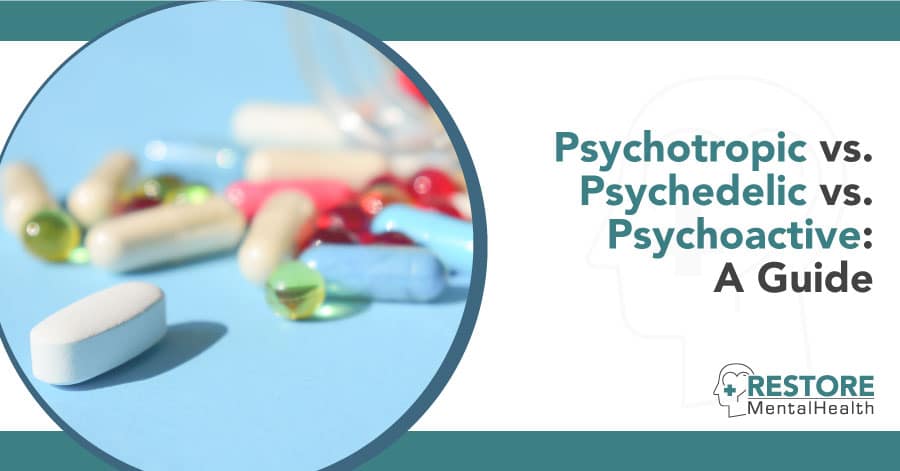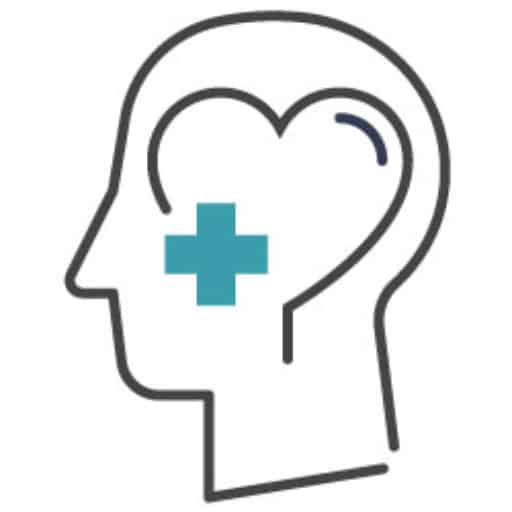Updated September 13, 2023
In day-to-day life, the terms “psychoactives,” “psychedelics,” and “psychotropics” are often used interchangeably. While each type of drug has some effect on the brain, there are differences between them. The classification can be difficult to grasp because many drugs overlap in different categories. For example, all psychedelic drugs are psychoactive, but not all psychoactive drugs are psychedelic.
When it comes to comparing psychoactive and psychotropic drugs, many sources define them as the same thing. This is even true in peer-reviewed academic literature. Other sources note a subtle difference between the two terms. This article provides a detailed guide to the difference between these types of drugs. It also discusses which types of drugs fall into each category and the risks that are associated with each type.
What Is a Psychotropic Drug?
Psychotropic drugs are medications that are typically used to treat a range of psychiatric disorders. They alter mood, emotional state, and behavior and work, by targeting the limbic system, which is responsible for emotional regulation. For this reason, these drugs are used to treat conditions such as depression, anxiety and schizophrenia.
Some examples of psychotropic drugs include:
- Antidepressants
- Anti-epileptics (or anticonvulsants)
- Mood stabilizers
- Antipsychotics
While these drugs can be effective in treating neurological and psychiatric illnesses, they come with a host of side effects. Side effects can be mild or severe. These effects may include stomach upset, gastrointestinal problems, sexual dysfunction, anxiety, and depression, for example.
It’s important to work closely with a mental health professional when considering psychotropic medication. Moreover, it’s especially important to report any side effects, especially if they are severe. In many cases, physicians can prescribe a different medication that may be a better fit, chemically speaking, for the individual.
Other Definitions
It’s worth noting that the delineation between psychoactive and psychotropic drugs isn’t always clear. Some scientific sources make no distinction between these two classes of drugs, and finding clear definitions for each isn’t altogether straightforward. But for those who accept the difference, psychoactive substances are defined as anything that crosses the blood-brain barrier, whereas psychotropic drugs lead to noticeable changes in mood and cognition. Psychotropics are also typically used to treat severe neuropsychiatric conditions like schizophrenia or epilepsy.
What Is a Psychedelic Drug?
Psychedelic drugs are drugs that cause changes in mood, perception, and cognition. They can distort your sense of reality and cause you to perceive things that aren’t actually there. Psychedelic plants have a rich cultural history and have been used by indigenous cultures for thousands of years. They’re known for inducing mystical experiences, and today there are more than 30 million users of psychedelics in the United States. Common psychedelic drugs include:
- LSD
- Magic mushrooms
- DMT
- Ayahuasca
- Ketamine
While psychedelic drugs are currently being studied for potential therapeutic applications, in rare cases they can lead to schizophrenia and schizophrenic-type disorders in genetically predisposed people. Evidence suggests that psychedelics have a low potential for addiction and are generally considered safe in low doses for healthy individuals. However, these drugs are illegal in most countries and still involve safety risks.
Moreover, there are recorded incidences of psychedelic-induced psychotic breaks. The problem is, users don’t know how they’ll react before taking them, as there’s no way of knowing if they are genetically predisposed to schizophrenia or psychosis. Moreover, the drugs may not be regulated—certainly not if purchased on the street. Other chemicals may be present or the dosing may be high. Consequently, a person who takes a drug and seems to tolerate it well one time might not tolerate the same drug another time, because other chemicals may be present or the dosing may be different.
What Is a Psychoactive Drug?
Psychoactive drugs are drugs that affect the brain in any way. They can lead to changes in a person’s mental state but don’t necessarily get them high. Some sources define psychoactive as anything that crosses the blood-brain barrier, including caffeine, nicotine, and many other types of mild drugs. Psychoactive drugs don’t necessarily induce noticeable changes to a person’s mental state, although they can. According to the World Health Organization, 270 million people, or 5.5 percent of the world’s population, used psychoactive drugs in 2021.
Psychoactive drugs can be divided into four major categories: stimulants, depressants, opiates and hallucinogens.
Stimulants
Stimulants are substances that increase activity in the brain and body—in other words, they have an excitatory effect. Their effects range from helping keep you awake and alert to increasing your heart rate and blood pressure. Examples of stimulants include caffeine and nicotine. They also include illicit drugs like cocaine, speed and methamphetamines. Stimulants, especially those that are illegal like meth, can be highly addictive. Even with treatment, the rate of relapse for meth addiction is over 90 percent.
Stimulants work by interacting with certain neurotransmitters (brain chemicals) that relay messages between nerve cells. For instance, caffeine binds to adenosine receptors in the brain, preventing them from having their usual sleep-inducing effect. In general, stimulants increase alertness, attention, and energy levels, by inhibiting the effects of sleep pressure.
Depressants
Depressant substances slow down the central nervous system. They work by affecting neurotransmitters that regulate mood and cognition. As a result, depressants can cause drowsiness and impaired cognition and create the feeling of being high. Common examples of depressants include alcohol, barbiturates, and benzodiazepines. Barbiturates may be prescribed for insomnia or sleep disorders while benzodiazepines are often prescribed to treat anxiety.
While some of these substances can be therapeutic when used properly, they have the potential for abuse. Overuse may lead to addiction and other serious health problems. Depressant drugs are dangerous when combined with other substances like opioids or Valium. Each drug can amplify the other’s effects and lead to respiratory failure. For this reason, it’s important to be aware of the risks associated with depressant drugs before using them.
Opiates
Opiates are a class of drugs that includes both legal drugs like oxycodone and hydrocodone and illegal drugs like heroin. Opiates work by binding to opioid receptors in the brain, reducing pain signals, and creating a feeling of euphoria, which is why they may lead to addiction, tolerance and physical dependence.
Opiates are extremely addictive and involve relapse rates of more than 85%. Opiate overdose drives the high rate of drug-related deaths in the U.S. Opioids like heroin target the brain’s reward center which is located near the brain’s controls for respiratory function. Even a slight dose increase suppress the respiratory system, resulting in slow or even stopped breathing. Since 1999, more than 450,000 people have died as a result of an opioid overdose.
Hallucinogens
Hallucinogens are a class of drugs that produce changes in perception, mood and thought. Commonly used hallucinogens include LSD, magic mushrooms and ketamine. These drugs cause the user to see, feel or hear things that aren’t actually there. Some users report feeling more open and connected to others, while others may feel terrified or out of control. Hallucinogens are also referred to as psychedelics, falling under the broader category of psychoactive drugs.
Precautions
While psychoactives, psychedelics, and psychotropics all have potential for therapeutic benefits when used under professional supervision, they also all have potential for causing harm. Because of their effects on cognition, using them may lead to accidents or serious injuries. Moreover, some of these drugs, while often prescribed, have a high potential for abuse. Opiates like heroin, stimulants like meth, and depressants like alcohol pose a high risk for addiction and physical dependency. Medications that are prescribed by healthcare providers should be taken as directed. Increasing one’s dose without a physician’s knowledge can be a first step toward addiction.
Need Help?
While the difference between psychoactive vs. psychotropic or psychotropic vs. psychedelic isn’t always clear, each of these drug classes carries the potential for abuse and harm. If you or someone you know is suffering from the negative health effects of any of these drugs, contact Restore Mental Health today at (877) 594-3566.



